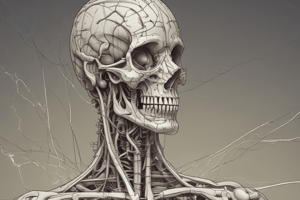Podcast
Questions and Answers
Which neurotransmitter is primarily associated with the sympathetic nervous system?
Which neurotransmitter is primarily associated with the sympathetic nervous system?
- Acetylcholine
- Dopamine
- Norepinephrine (correct)
- Serotonin
What effect does the activation of the sympathetic nervous system have on heart rate and blood pressure?
What effect does the activation of the sympathetic nervous system have on heart rate and blood pressure?
- Increases heart rate and decreases blood pressure
- Increases heart rate and blood pressure (correct)
- Decreases heart rate and blood pressure
- Decreases heart rate and increases blood pressure
Which of the following is an example of a sympathomimetic drug?
Which of the following is an example of a sympathomimetic drug?
- Atropine
- Prazosin
- Epinephrine (correct)
- Propranolol
What is the primary function of the parasympathetic nervous system?
What is the primary function of the parasympathetic nervous system?
Which receptor type is primarily associated with the stimulation of smooth muscles and glands?
Which receptor type is primarily associated with the stimulation of smooth muscles and glands?
What is the effect of beta-2 agonists like albuterol?
What is the effect of beta-2 agonists like albuterol?
Which drug is used to block muscarinic receptors?
Which drug is used to block muscarinic receptors?
What is the effect of activating alpha-1 receptors?
What is the effect of activating alpha-1 receptors?
Flashcards
What is the Autonomic Nervous System (ANS)?
What is the Autonomic Nervous System (ANS)?
The autonomic nervous system (ANS) controls involuntary functions like heart rate, digestion, and breathing. It has two branches: the sympathetic nervous system (SNS) and the parasympathetic nervous system (PNS).
What is the Sympathetic Nervous System (SNS)?
What is the Sympathetic Nervous System (SNS)?
The SNS is like the 'fight-or-flight' response, preparing you for action and stress. It increases heart rate, breathing, and alertness.
What is the Parasympathetic Nervous System (PNS)?
What is the Parasympathetic Nervous System (PNS)?
The PNS is like the 'rest-and-digest' response, calming you down and promoting relaxation. It slows heart rate, increases digestion, and relaxes muscles.
What is Norepinephrine?
What is Norepinephrine?
Signup and view all the flashcards
What is Acetylcholine?
What is Acetylcholine?
Signup and view all the flashcards
What are Sympathomimetics (Adrenergic Agonists)?
What are Sympathomimetics (Adrenergic Agonists)?
Signup and view all the flashcards
What are Parasympathomimetics (Cholinergic Agonists)?
What are Parasympathomimetics (Cholinergic Agonists)?
Signup and view all the flashcards
What are Sympatholytics (Adrenergic Antagonists)?
What are Sympatholytics (Adrenergic Antagonists)?
Signup and view all the flashcards
Study Notes
Autonomic Nervous System Subdivisions
- The autonomic nervous system (ANS) regulates involuntary functions like heart rate, digestion, and breathing.
- The sympathetic and parasympathetic nervous systems are its subdivisions.
Sympathetic Nervous System (SNS)
- Function: The "fight-or-flight" response, activated during stress or emergencies.
- Key Neurotransmitters: Norepinephrine (primary), and epinephrine.
- Effects:
- Increases heart rate and blood pressure.
- Dilates bronchi (improves airflow).
- Dilates pupils.
- Inhibits digestion and urinary activity.
- Stimulates glucose release for energy.
- Agents Influencing SNS:
- Sympathomimetics (Adrenergic Agonists): Stimulate adrenergic receptors.
- Examples: Epinephrine, norepinephrine, albuterol.
- Uses: Asthma, hypotension, anaphylaxis.
- Sympatholytics (Adrenergic Antagonists): Block adrenergic receptors.
- Examples: Beta-blockers (e.g., propranolol), alpha-blockers (e.g., prazosin).
- Uses: Hypertension, arrhythmias, anxiety.
- Sympathomimetics (Adrenergic Agonists): Stimulate adrenergic receptors.
Parasympathetic Nervous System (PNS)
- Function: The "rest-and-digest" system, active during relaxation.
- Key Neurotransmitter: Acetylcholine.
- Effects:
- Decreases heart rate.
- Constrics bronchi.
- Stimulates digestion and gland secretion.
- Promotes bladder contraction and urination.
- Constricts pupils.
- Agents Influencing PNS:
- Parasympathomimetics (Cholinergic Agonists): Stimulate cholinergic receptors.
- Examples: Bethanechol, pilocarpine.
- Uses: Urinary retention, glaucoma.
- Parasympathomimetics (Cholinergic Agonists): Stimulate cholinergic receptors.
Receptor Types and Manipulation
-
Adrenergic Receptors (SNS):
- Alpha-1: Vasoconstriction, pupil dilation (blocked by alpha-1 antagonists).
- Alpha-2: Inhibits norepinephrine release (stimulated by clonidine).
- Beta-1: Increases heart rate, contractility (blocked by beta-1 blockers like metoprolol).
- Beta-2: Bronchodilation and vasodilation (stimulated by beta-2 agonists like albuterol).
-
Cholinergic Receptors (PNS):
- Muscarinic: Found in smooth muscles, glands (blocked by atropine).
- Nicotinic: Found in ganglia and skeletal muscle (blocked by neuromuscular blockers like pancuronium).
Clinical Application
- Drugs manipulate these systems to treat conditions like asthma, hypertension, and more.
- Balancing activation and inhibition is crucial for therapeutic success.
Studying That Suits You
Use AI to generate personalized quizzes and flashcards to suit your learning preferences.




